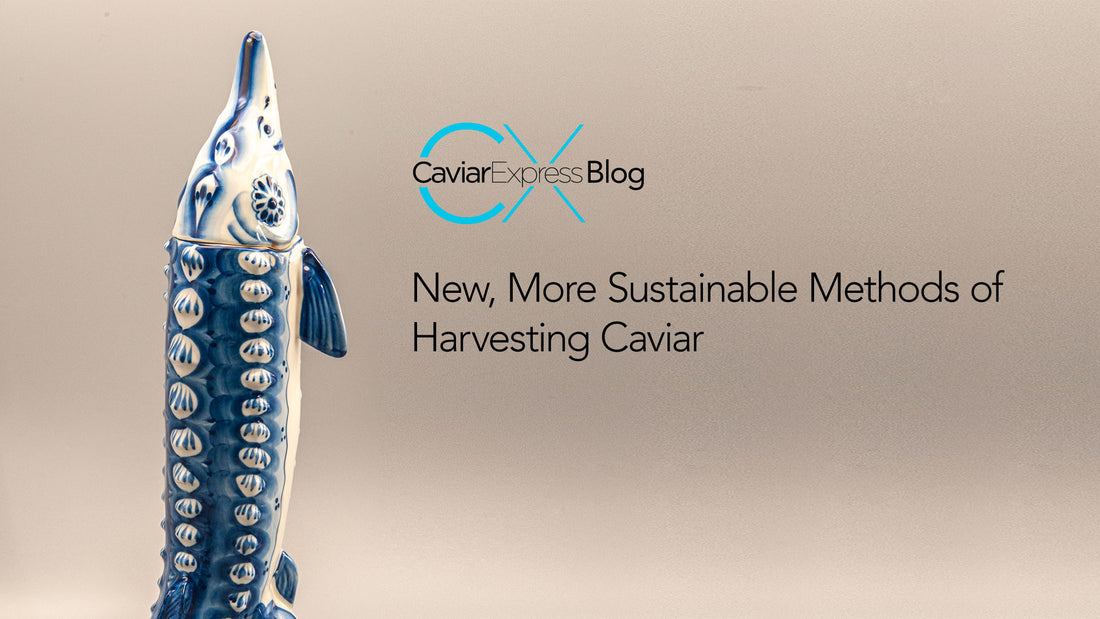
New, More Sustainable Methods of Harvesting Caviar
Share
We’ve written at length about why real caviar is so expensive, and part of the reason is how they are harvested from an endangered and protected species. If you’ve watched the video series on how caviar is actually harvested, the traditional method of getting the unfertilized roe out of a female sturgeon results in euthanizing the fish, which means taking an adult, fertile, and egg producing female fish out of the production process of creating future generations of sturgeons.
As you can imagine, this isn’t like getting freshly farmed eggs from a chicken. The end result is the caviar product we enjoy is expensive due to the production method, the length of time required for a population of egg producing sturgeon to come to adulthood, and the costly process of extracting the egg. When it comes to critically endangered subspecies like the Beluga sturgeon, with their unique and exquisite tasting caviar, the cost of extraction from such a limited stock means enjoying some Beluga caviar can be prohibitive.
In addition, different sturgeon individuals produce different grades of caviar. The quality and quantity of the roe that determine the grade of the caviar can only be truly determined after extraction. So if a particular individual sturgeon produce high quality roes that can be processed into higher grade due to the consistent size, color, and taste, once the roe is harvested, the same individual can no longer produce the same high quality caviar.
But, there are some exciting, sustainable methods on the horizon.
No-kill Harvesting
Even as the industry move toward ways to keep an endangered and protected species around, the current method of farming certain sturgeon species still require a decade long process to harvest a limited amount of caviar. These majestic, ancient species of fish can live well past the human lifespan, but for harvesting purposes they’re euthanized soon after they start producing eggs.
The drive to further protect the species have seem advances in “no-kill” harvesting methods. Due to the way the roes are processed, the method of extraction requires an immediate bath in calcium-based solution to help the roes retain structural integrity.
Video courtesy of Cool Goby Fish on YouTube of Aquatir, a sturgeon/caviar farm in Germany.
There are actually a couple of competing methods of more humane, no-kill harvesting gaining traction in the industry. One is the aforementioned patented Vivace method, where the roes is extracted in a “milking” method that requires the calcium-solution bath. The other process has actually been around since the early Roman period, but it’s never been applied to harvesting sturgeons until now: C-section. A small incision is made in the fish’s belly, the eggs are extracted, then the sturgeon is sewn up and bandaged and allowed to heal.
Both of these method means the sturgeon is not destroyed in the process of harvesting the caviar, and a healthy, productive female can continue to be harvested every couple of years for her quality roes. In a fish that can live to be 100 years old, that means that instead of a decade long wait for a juvenile to be matured enough to produce eggs, a fish can be harvested repeatedly until they’re too mature to produce high quality caviar, then she can be released back to the population to produce future generations of caviar producing sturgeons.
So What Does This Mean for us Caviar Lovers?
Even though these methods of harvesting are still in its infancy, the end results speak for themselves. Both methods allow for keeping a productive female sturgeon alive, while shortening the farming cycle to 2 years per harvest rather than at least 10. The sturgeon population is preserved in the process of procuring these precious delicacies, thus driving down the cost and increasing the availability of certain rare caviars.
At Caviar Express, we are looking forward to source our caviar from responsible, renewable and sustainable sources, and hope to one day in the near future, pass the savings along to you, our valued caviar family.
